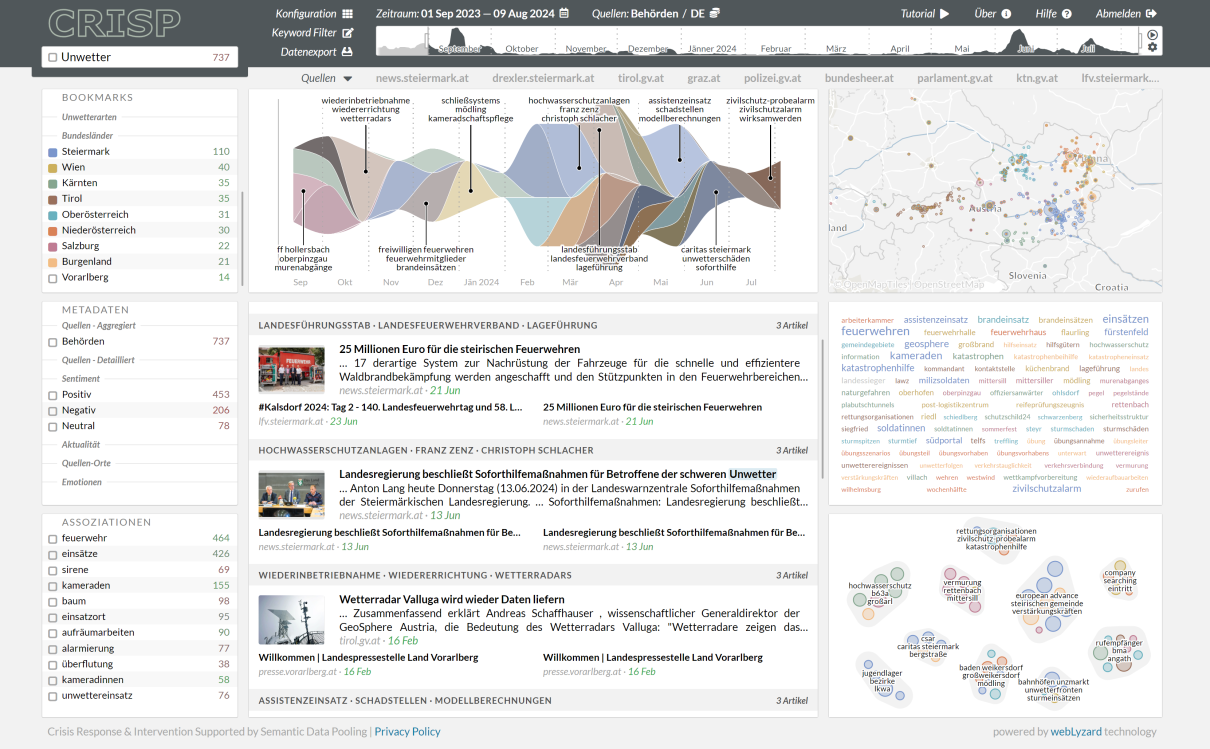CRISP – Crisis Response Project
The CRISP project represents a data-driven approach to Crisis Response and Intervention. It considers both the short-term management of disasters as well as long-term economic impact assessments at high regional and temporal granularity. For this purpose, CRISP will ingest data from multiple heterogeneous sources, shedding light on the impact of response and intervention strategies in close to real time. The result is a comprehensive and continuously updated data pool, which represents a key asset for semantic modelling and impact forecasting.
CRISP will not only increase the transparency of crisis response and intervention processes, but also capture how the resulting outcomes are being perceived by citizens and professional stakeholders.
Visual Exploration for Decision Makers
We will extend the visual analytics dashboard to support the heterogeneous formats of the data pool. This will result in a visual exploration system for decision makers to track recent developments in (near) real time, as well as the predicted impact in order to determine the threat level and need for alerts. Available through a modular Application Programming Interface (API), the built-in data services will provide important features for prescriptive models to avert or mitigate the effects of natural disasters, with a particular focus on severe weather events. Individual widgets of the dashboard will be provided as embeddable components for public-facing Web sites and the applications of consortium partners and the members of the CRISP Stakeholder Forum.
Data Management Ecosystem
CRISP will build the necessary data ecosystem that allows to integrate relevant, heterogeneous sources such as the ZAMG database VIOLA (Violent Observed Local Assessment), open government data, closed data from municipalities as well as unstructured data from news and social media sources. All datasets will remain under full control of the data owners or publishers, reflecting the project’s decentralized approach to data management.
Crisis Response Semantic Data Pool
CRISP will assess and improve data quality and integrate the wide range of data sources in a common semantic metamodel. Semantics from generic and custom knowledge graphs as well as language models from large textual corpora based on news and social media will help to accurately extract relevant metadata and actionable indicators and signals.
Impact Prediction
CRISP will improve impact prediction capabilities based on the semantic data pool. In order to improve the Austrian risk assessment in the field of natural hazard prevention, adaptation and rehabilitation, we will derive optimal features for machine learning algorithms and use them to build:
- models learning from the past to further develop and improve regional severe weather forecast models,
- models for efficient short-term impact prediction of natural disasters at a granular regional level, as well as
- models for long-term, economic impact assessment for municipalities and regions to capture the complex costs and damages of different types of events. The same models will be extended to stress-test climate model outcomes, and to explore counterfactuals.
Project Start: 01 December 2021; Coordinator: webLyzard technology; Project Partners: Complexity Science Hub Vienna, Austrian Central Institution for Meteorology and Geodynamics (ZAMG), nexyo and the Center for Public Administration Research (KDZ). The CRISP project is funded by the Austrian Federal Ministry for Climate Action, Environment, Energy, Mobility and Technology (BMK) via the ICT of the Future Program – FFG No 887554.




